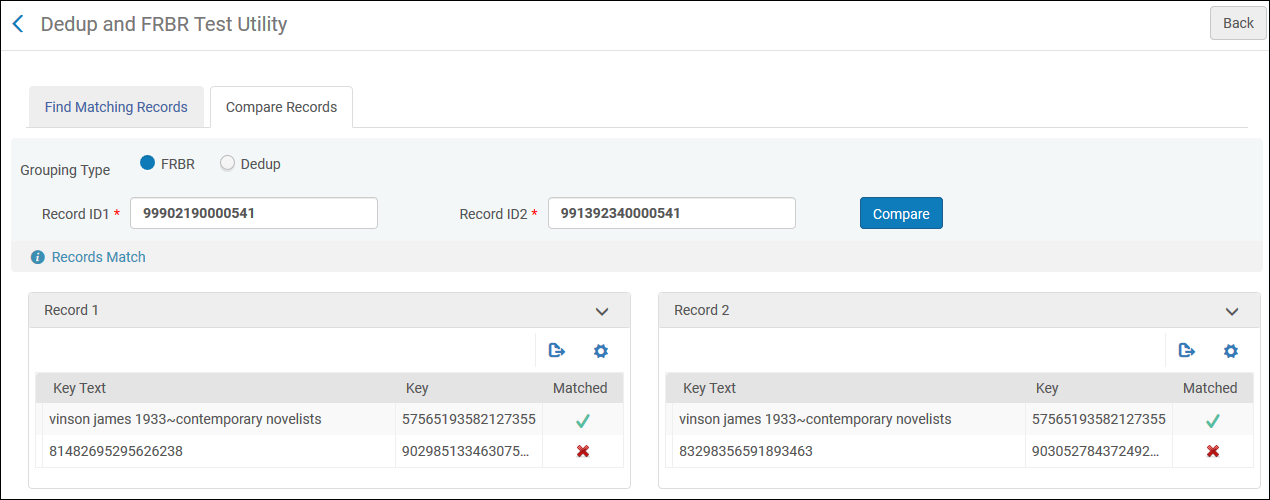Dedup and FRBR Analysis Tool for Primo VE
The Dedup and FRBR Test Utility page (Configuration Menu > Discovery > Other > Dedup and FRBR Test Utility) enables you to perform the following tests to analyze how the system determines whether records belong to Dedup/FRBR groups, which are used to reduce redundant records in the brief results:
-
Find matching records – This test enables you to find a record's matching FRBR or Dedup records.
-
Recalculate Dedup and FRBR Groups – This option enables you to recalculate Dedup and FRBR groups after updating a record's metadata.
-
Compare records – This test enables you to compare two records to determine whether they belong to the same FRBR or Dedup group.
For more details, see Understanding the FRBR/Dedup Processes.
How to Test Dedup and FRBR (3 min)
Find Matching Records
The Find Matching Records tab enables you to analyze a specific record to find its matching records and determine which keys were used to match records. The output includes the following sections:
-
In the Record Keys section, the system displays the following information:
Column Description Key Source The source of the Primo VE fields from which the key is created. If the source is enclosed by square brackets, the source is optional, and the key is generated even if the key does not exist. Description The description for the key. Key Text The normalized value of the Primo VE field, which is used to create the key. Key The hash number that was generated from the text and used to find matching records. -
In the Matching Records section, the system displays all records that belong to the same Dedup or FRBR group as the specified record. For each record, the system displays the record ID (MMS ID), title, and Dedup ID (if applicable). For each matching record, you can display the keys that connected the records (View mutual keys row action) and view all keys (View keys row action).
-
Open the Dedup and FRBR Test Utility page (Configuration Menu > Discovery > Other > Dedup and FRBR Test Utility).
-
Select the Find Matching Records tab.
-
Select the grouping type: Dedup or FRBR.
-
In the Record ID field, enter a record's MMS ID and then select Find matching records. If the record has any matching records, the matching records appear in the list.
The following example shows a matching record in the FRBR group:
 Matching Record Found
Matching Record FoundFor each matching record, you can perform the following row actions:
- View mutual keys – displays all keys that matched keys in the specified record.
- View keys – displays all keys for the matching record.
Recalculate Dedup and FRBR Groups
After making changes to a record's metadata, the FRBR and Dedup groups may need to be recalculated. The Recalculate FRBR and Dedup groups option enables you to recalculate FRBR and Dedup groups.
This process may take a while to complete.

-
On the Dedup and FRBR Test Utility page (Configuration Menu > Discovery > Other > Dedup and FRBR Test Utility), enter the modified record's MMS ID.
-
Select Find matching records.
-
Select Recalculate FRBR and Dedup groups.
Compare Records
The Compare Records tab enables you to compare two records to determine whether the records belong to the same FRBR or Dedup group. After execution, any of the following statuses may appear below the specified records:
-
Records match – The records have at least one matching key, and the records are currently connected in the database.
-
No match – The records have no matching keys, and the records are not currently connected in the database.
-
Records match but are not connected in the database – The records have at least one matching key, but the records are not currently connected in the database. This can happen either when a record's metadata has been changed, but it has not been re-indexed or when a record matches the current record but is connected to a different group that it also matches.
-
No matching keys. Records are connected in the database – The records have no matching keys, but records are currently connected in the database. This can happen due to metadata changes that have not been re-indexed for a record or due to transitivity, which may occur when records A and C are compared, but FRBR groups have been defined only for records (AB) and (BC), but not for (AC).
To discover where the connection is in the database, select the Find connection button. If you do not find a connection, it could be because a record has been deleted, edited, or suppressed or because of transitivity.
To determine why the records did or did not match, you can compare the following information for each field:
| Column | Description |
|---|---|
| Key Text | The normalized value of the Primo VE field, which is used to create the key. |
| Key | The hash number that was generated from the text and used to find matching records. |
| Matched | Indicates whether the key matched the key in the other record. |
Comparisons for which both records are suppressed from Dedup returns the following message:
-
Select the Compare Records tab.
-
Select the grouping type: Dedup or FRBR.
-
In the Record ID1 and Record ID2 fields, enter the MMS IDs of the records that you want to compare and then select Compare. Whether there is a match or not, the key information appears for each record so that you can see why the records were not grouped together.
The following example indicates that both records belong to the same FRBR group based on the first key in the list:
 Records Belong to the Same FRBR Group
Records Belong to the Same FRBR Group

